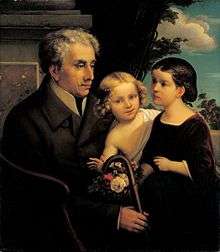Alexander Haindorf

Alexander Haindorf (2 May 1784 – 16 October 1862) was a physician, a Jewish reformer, psychologist, university lecturer, journalist, art collector and co-founder of the Westphalian Kunstverein.
Biography
Haindorf was born under the name Hirsch-Alexander in modern-day Finnentrop during the spring of 1784. Thanks to his devout merchant parents, Haindorf received education under a rabbi, and from an early age was driving towards a career in Talmud study, continuing through exposure to the rejection of the Jewish community by the Catholic majority. After the death of his parents, Haindorf was taken into the care of his grandparents in Hamm, who pushed the child towards abandoning his interest in science and religion in favor of a more practical, commercialized career. Later, he came into contact with the superintendent of Jewish communities in the County of Mark, Ansel Hertz. Through Hertz, Haindorf became the first Jew to attend the prestigious Hamm institution Hammonense, from which he was able to enroll in medicine, psychology, and philosophy courses in the University of Würzburg, the University of Jena, and the Heidelberg University, while also taking interest in historical science. In 1808, he officially adopted the name Haindorf, and two years later published an award winning thesis entitled Schrift über die Pathologie und Therapie der Gemüts-und Geisteskrankheiten (The Pathology and Treatment of Emotional and Mental Disorders).
Following his 1810 thesis, Haindorf became the first Jewish private lecturer at Heidelberg. Haindorf was later offered a position as a university professor, which he refused for both objective and religious reasons. Leaving Heidelberg in 1812, Haindorf traveled to France in 1814 on an academic travel. Finding the institutions in France to be both underfunded and lacking educationally, Haindorf wrote a book on his experiences and returned to Germany, where he was employed as a psychology lecturer at the University of Göttingen. In 1815, Haindorf entered into military service as a doctor stationed in Wesel. Following a transfer to Münster, he applied for a job at the University of Münster, where he was gainfully employed until the closure of its surgery educational establishment. Haindorf then applied for a teaching job, but was denied due to his Jewish heritage. Following this, Haindorf became a popular nerve surgeon to nobility centered in Westphalia.
Haindorf later began openly supporting Jewish emancipation, becoming a member of a Berlin pro-reform movement in 1822. Years later, Haindorf and his father-in-law Elias Marks founded an inclusion movement for Jews, known as the Marks-Haindorf Foundation, promoting the integration of the Jews into bourgeois society, in order finally to reach tolerance for the Jews themselves. The model school connected teacher training to a pedagogically holistic approach. These included the inclusion of musical and sporting education, as well as coeducation. It tried to convey humanity, practical tolerance, and Prussian patriotism. The movement became so accepted that in 1839, Protestants began accepting the program, sending their children to mixed schools. Haindorf's movement also had a great amount of political support, the Vincke family of the Westphalian nobility associated with the movement publicly, and granted it considerable jurisdiction in its favor following alliances spearheaded by several political entities. The program later stretched across all of Westphalia and even entered the Rhine.
Haindorf oversaw the foundation until his death in 1862. He is buried in the Jewish Cemetery of Münster.